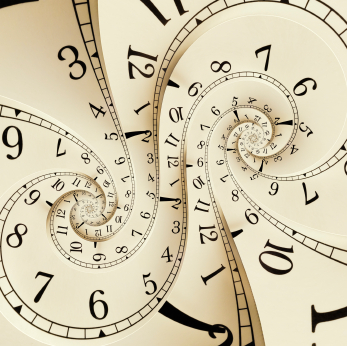Wednesday Bubble: The Magic Menopause Ball
 Can you accurately pinpoint the timing of your final menstrual period? Lord, I finally hope so because if you are anything like me, 50+ and over this bleeding thing, the ability to read into the magic menopause ball sounds like heaven. However, more importantly, it may have significant benefits for women’s health overall. For example, knowing when you will enter menopause provides you with the ability to address bone loss and other risks now (the rate of bone loss greatly accelerates to roughly 2.6% in the year prior through two years after menopause). And there’s no time like the present to start bolstering your defenses against the health-related ravages of aging.
Can you accurately pinpoint the timing of your final menstrual period? Lord, I finally hope so because if you are anything like me, 50+ and over this bleeding thing, the ability to read into the magic menopause ball sounds like heaven. However, more importantly, it may have significant benefits for women’s health overall. For example, knowing when you will enter menopause provides you with the ability to address bone loss and other risks now (the rate of bone loss greatly accelerates to roughly 2.6% in the year prior through two years after menopause). And there’s no time like the present to start bolstering your defenses against the health-related ravages of aging.
This post comes with a warning: it’s a bit geeky science-y. Some topics are harder than others to write about. However, I hope that you’ll bear with me and read on; it’s important.
This is not the first time that the future is being explored; you may recall another test that measures the antimullerian hormone, an ovarian marker that relates to the number of immature follicles a woman has (as the marker declines, so do the number of eggs a woman houses, and the closer to menopause she is). Another way to gauge the start of menopause is to monitor bleeding patterns. Not only is this onerous, but, data suggest that more than 60% of women in early perimenopause become postmenopausal with no apparent signs.
A new approach to pinpoint the timing of menopause involves a calculation of changing levels of estradiol (the most important form of estrogen in the body) and follicle stimulating hormone (FSH – the hormone produced by the pituitary gland that stimulates the ovaries to produce eggs). The closer a woman is to menopause, the higher the FSH levels and the lower the estrogen levels. To determine if this test is valid, researchers developed a model based on data collected from 574 women in the ongoing Study of Women’s Health Across the Nation (SWAN). These women were all between the ages of 42 and 53, had an intact uterus and at least one ovary and were not taking hormones. They were ethnically diverse (Caucasian, African-American and Asian) and had given blood samples over a ten year period.
The findings? After adjusting for factors that might influence menopause, including age, smoking and weight, they found that measuring FSH and estradiol could accurately pinpoint three major timepoints: roughly two years and one year prior to the final menstrual period and the final menstrual period. Moreover, the ability of the test to predict the final period increased as women moved closer to the goal.
Now, scientists use variables to gauge how well a test can predict the number of people with a condition (sensitivity) as well as how well a test can identify those people without the condition (specificity). The new model was shown to be able to accurately identify 89% of women who reached their final menstrual period, which is excellent.
Scientific mumbo jumbo aside, the upshot is that it’s likely that we’ll be able to predict the date of our final menstrual with great accuracy in the near future. Better than an 8-ball. The answer is ‘Yes.’
[This study appears in the April 2013 issue of the Journal of Clinical Endocrinology and Metabolism.]
Read MoreMarking the ‘pause
 Back in 2009 and 2010, I wrote about a marker for menopause — the antimüllerian hormone (AMH) — which theoretically can accurately predict when a woman will enter menopause within a margin of three to four years. AMH is first detected in the ovarian cells when a woman is 36 weeks pregnant and continues until preimenopause. More specifically, it correlates to immature follicles in the ovaries whose role it is to house mature eggs. The greater the number of these follicles, the more likely it is that a woman will conceive. This is why AMH disappears as a women enters menopause, and why it has been identified as a marker of ovarian aging. Researchers have also discovered that women who have AMH levels that are below average for their age are likely to enter menopause up to 10 years before the average age of most women, 52 years. The importance of this cannot be overstated; one of the goals of this blog is to help you prepare for menopause and the changes that accompanying it. Hence, being able to predict when menopause may start can help you address certain potential health issues related to declining estrogen before they become full blown, e.g., elevated cholesterol.
Back in 2009 and 2010, I wrote about a marker for menopause — the antimüllerian hormone (AMH) — which theoretically can accurately predict when a woman will enter menopause within a margin of three to four years. AMH is first detected in the ovarian cells when a woman is 36 weeks pregnant and continues until preimenopause. More specifically, it correlates to immature follicles in the ovaries whose role it is to house mature eggs. The greater the number of these follicles, the more likely it is that a woman will conceive. This is why AMH disappears as a women enters menopause, and why it has been identified as a marker of ovarian aging. Researchers have also discovered that women who have AMH levels that are below average for their age are likely to enter menopause up to 10 years before the average age of most women, 52 years. The importance of this cannot be overstated; one of the goals of this blog is to help you prepare for menopause and the changes that accompanying it. Hence, being able to predict when menopause may start can help you address certain potential health issues related to declining estrogen before they become full blown, e.g., elevated cholesterol.
The powers that be have recently defined two phases of the menopause transition; the early phase, in which menstruation becomes more variable and cycle length changes by 7 days or more, and the late phase, in which women miss two or more periods, experiencing at least one 60 day cycle and have elevated FSH hormone levels. These phases became the anchor for the AMH study because they allowed the researchers to weigh its potential as a marker over time. That’s exactly what they set out to do (you can find the study published in the latest issue of Menopause.)
Using a new assay testing kit that appears to be more sensitive than its predecessors, they selected 44 women from a pool of 595 whose blood samples were taken randomly over a six year period and measured AMH. It was important that these women met criteria that would allow their AMH to be accurately measured; these included being over age 40 and menstruating regularly when they first had blood drawn, or having regular then irregular periods, not taking any medication that might affect their menstrual cycles and providing ample number of samples (at least three) over a five year time period.
The findings? Roughly three years before women entered what is considered the late stage menopausal transition, AMH blood levels became virtually undetectable. Moreover, the proportion of women with undetectable AMH levels constantly increased, which supports the hypothesis that AMH levels below a certain point may predict progression into the late phase of the menopausal transition. Similarly, over the time course of the study, the percentage of women with low AMH levels increased by about 71% as they approached the late menopausal transition.
The numbers in the study were small so the results, while important, stil need to be borne out in larger sample sizes. But, it appears promising that AMH can detect menopause within three years, a healthy dose of reality that may ultimately prove important in disease prevention as we age.
Read More





